Analysis of Bearing Characteristics of Energy Pile Group Based on Exponential Model
Abstract
:1. Introduction
2. Governing Equations for Pile Group Settlement
2.1. Pile Shaft Response
2.2. Pile Base Response
2.3. Pile-Pile Interaction
3. Solution of the Analytical Model
3.1. Governing Equation for Single Pile
3.2. Solution of Governing Equation under Mechanical Load
3.3. Solution of Governing Equation under Thermal Load
4. Model Validation
4.1. Case with Mechanical Loading
4.2. Case with Thermomechanical Loading
5. Analysis of the Bearing Performance of Energy Pile Group
5.1. Simulation Background
5.2. Simulation Results
6. Conclusions
Author Contributions
Funding
Institutional Review Board Statement
Informed Consent Statement
Data Availability Statement
Conflicts of Interest
References
- Kong, G.; Fang, J.; Huang, X.; Liu, H.; Abuel-Naga, H. Thermal induced horizontal earth pressure changes of pipe energy piles under multiple heating cycles. Geomech. Energy Environ. 2020, 26, 100228. [Google Scholar] [CrossRef]
- Maragna, C.; Loveridge, F. A New Approach for Characterizing Pile Heat Exchangers Using Thermal Response Tests. Energies 2021, 14, 3375. [Google Scholar] [CrossRef]
- Jensen-Page, L.; Loveridge, F.; Narsilio, G. Thermal Response Testing of Large Diameter Energy Piles. Energies 2019, 12, 2700. [Google Scholar] [CrossRef] [Green Version]
- Ng, C.W.W.; Chao, S.; Gunawan, A.; Laloui, L.; Liu, H. Centrifuge modelling of heating effects on energy pile performance in saturated sand. Can. Geotech. J. 2014, 52, 150113073645001. [Google Scholar] [CrossRef]
- Suryatriyastuti, M.; Burlon, S.; Mroueh, H. On the understanding of cyclic interaction mechanisms in an energy pile group. Int. J. Numer. Anal. Methods Geomech. 2015, 40, 3–24. [Google Scholar] [CrossRef]
- Farhangi, V.; Karakouzian, M.; Geertsema, M. Effect of Micropiles on Clean Sand Liquefaction Risk Based on CPT and SPT. Appl. Sci. 2020, 10, 3111. [Google Scholar] [CrossRef]
- Mimouni, T.; Laloui, L. Behaviour of a group of energy piles. Can. Geotech. J. 2015, 52. [Google Scholar] [CrossRef]
- Peng, H.; Kong, G.; Liu, H.; Abuel-Naga, H.; Hao, Y. Thermomechanical Behaviour of Floating Energy Pile Groups in Sand. J. Zhejiang Univ. Sci. A 2018, 19, 638–649. [Google Scholar] [CrossRef]
- Fang, J.; Kong, G.; Meng, Y.; Wang, L.; Yang, Q. Thermomechanical Behavior of Energy Piles and Interactions within Energy Pile–Raft Foundations. J. Geotech. Geoenvironmental Eng. 2020, 146, 04020079. [Google Scholar] [CrossRef]
- Afsharhasani, R.; Karakouzian, M.; Farhangi, V. Effect of Competent Caliche Layers on Measuring the Capacity of Axially Loaded Drilled Shafts Using the Osterberg Test. Appl. Sci. 2020, 10, 6169. [Google Scholar] [CrossRef]
- Jeong, S.; Lim, H.; Lee, J.K.; Kim, J. Thermally induced mechanical response of energy piles in axially loaded pile groups. Appl. Therm. Eng. 2014, 71, 608–615. [Google Scholar] [CrossRef]
- Salciarini, D.; Ronchi, F.; Cattoni, E.; Tamagnini, C. Thermomechanical Effects Induced by Energy Piles Operation in a Small Piled Raft. Int. J. Geomech. 2013, 15. [Google Scholar] [CrossRef]
- Di Donna, A.; Laloui, L. Numerical analysis of the geotechnical behaviour of energy piles. Int. J. Numer. Anal. Methods Geomech. 2014, 39. [Google Scholar] [CrossRef]
- Saggu, R.; Chakraborty, T. Thermomechanical Response of Geothermal Energy Pile Groups in Sand. Int. J. Geomech. 2016, 16, 04015100. [Google Scholar] [CrossRef]
- Knellwolf, C.; Péron, H.; Laloui, L. Geotechnical Analysis of Heat Exchanger Piles. J. Geotech. Geoenviron. Eng. 2011, 137. [Google Scholar] [CrossRef]
- Frank, R.; Zhao, S.R. Estimation par les paramètres pressiométriques de 1′ enfoncement sous charge axiale de pieux forés dans des sols fins. Bull. Liaison Lab. Ponts Chauss 1982, 119, 17–24. [Google Scholar]
- Chen, D.; McCartney, J. Parameters for Load Transfer Analysis of Energy Piles in Uniform Nonplastic Soils. Int. J. Geomech. 2016, 17, 04016159. [Google Scholar] [CrossRef] [Green Version]
- Fei, K.; Zhu, Z.; Shi, Y.; Zhou, Y. A simplified method for geotechnical analysis of energy pile groups. Rock Soil Mech. 2020, 41, 3889–3898. [Google Scholar]
- Kezdi, A. Bearing capacity of piles and pile groups. In Proceedings of the 4th International Conference on Soil Mechanics & Foundation Engineering, London, UK, 12–24 August 1957; Volume 2, pp. 46–51. [Google Scholar]
- Huang, Y.P.; Jiang, G.; Lu, H.W.; Song, Z.; Xu, X.L.; Hong, X. Thermo-mechanical coupling load transfer method of energy pile based on exponential model. J. Nanjing Tech Univ. (Nat. Sci. Ed.) 2019, 41, 96–103. [Google Scholar] [CrossRef]
- Randolph, M.; Wroth, C.P. Analysis of Deformation of Vertically Loaded Piles. J. Geotech. Eng. Div. 1978, 104, 1465–1488. [Google Scholar] [CrossRef]
- Lee, K.M.; Xiao, Z. A simplified nonlinear approach for pile group settlement analysis in multilayered soils. Can. Geotech. J. 2001, 38, 1063–1080. [Google Scholar] [CrossRef]
- Badenes, B.; Magraner, T.; De Santiago, B.C.; Pardo, F.; Urchueguia, J. Thermal Behaviour under Service Loads of a Thermo-Active Precast Pile. Energies 2017, 10, 1315. [Google Scholar] [CrossRef] [Green Version]
- O’Neill, M.; Hawkins, R.; Mahar, L. Load Transfer Mechanisms in Piles and Pile Groups. J. Geotech. Eng. Div. 1982, 108, 1605–1623. [Google Scholar] [CrossRef]
- Castelli, F.; Maugeri, M. Simplified Nonlinear Analysis for Settlement Prediction of Pile Groups. J. Geotech. Geoenviron. Eng. 2002, 128. [Google Scholar] [CrossRef]
- Zhou, Y.; Tokimatsu, K. Numerical evaluation of pile group effect of a composite group. Soils Found. 2018, 58, 353–374. [Google Scholar] [CrossRef]
- Souri, A.; Abu-Farsakh, M.; Voyiadjis, G. Evaluating the effect of pile spacing and configuration on the lateral resistance of pile groups. Mar. Georesources Geotechnol. 2020, 39, 1–13. [Google Scholar] [CrossRef]

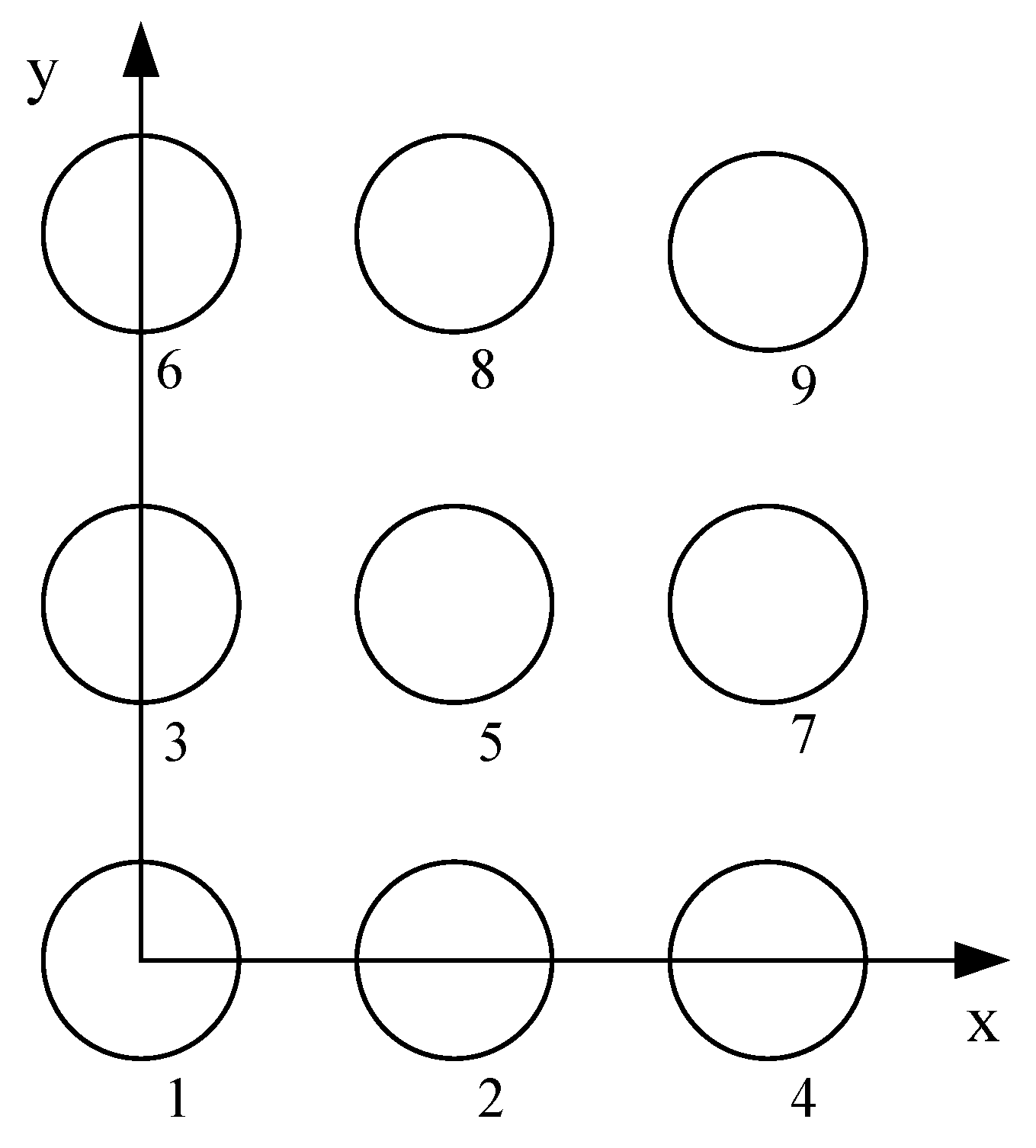
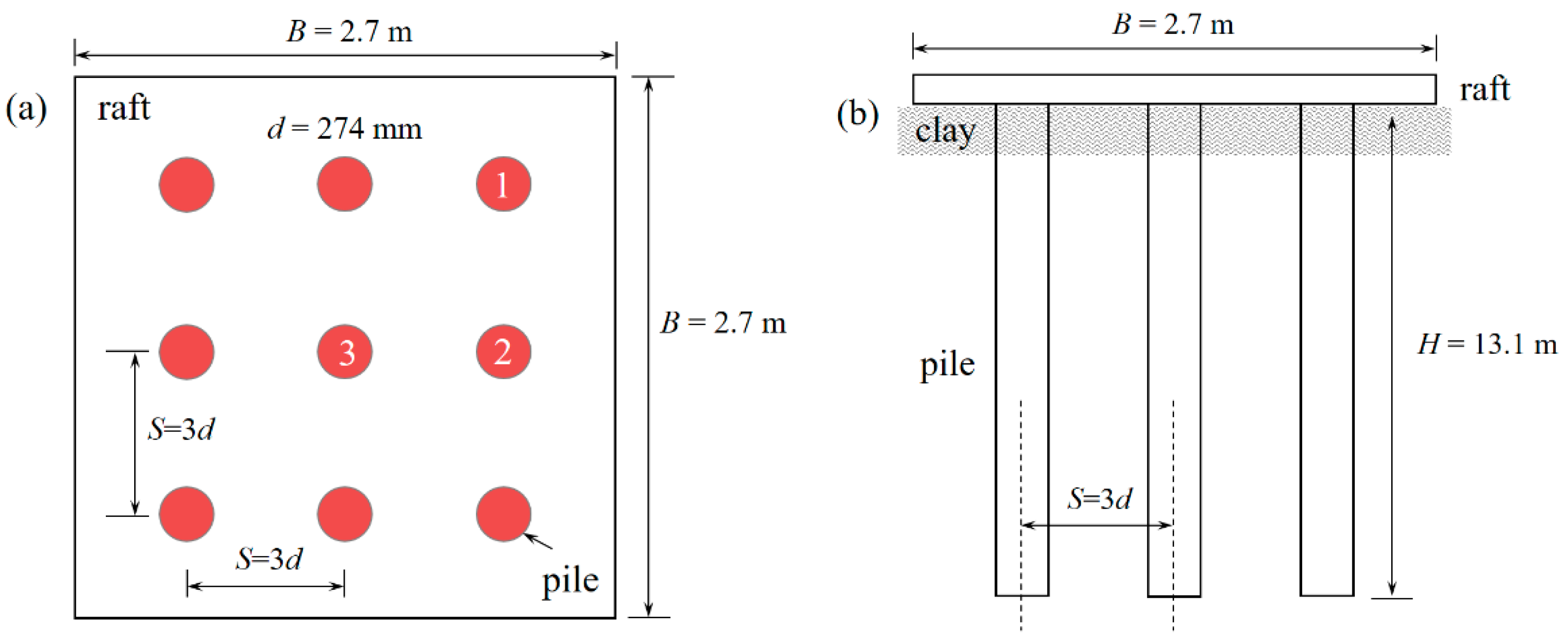
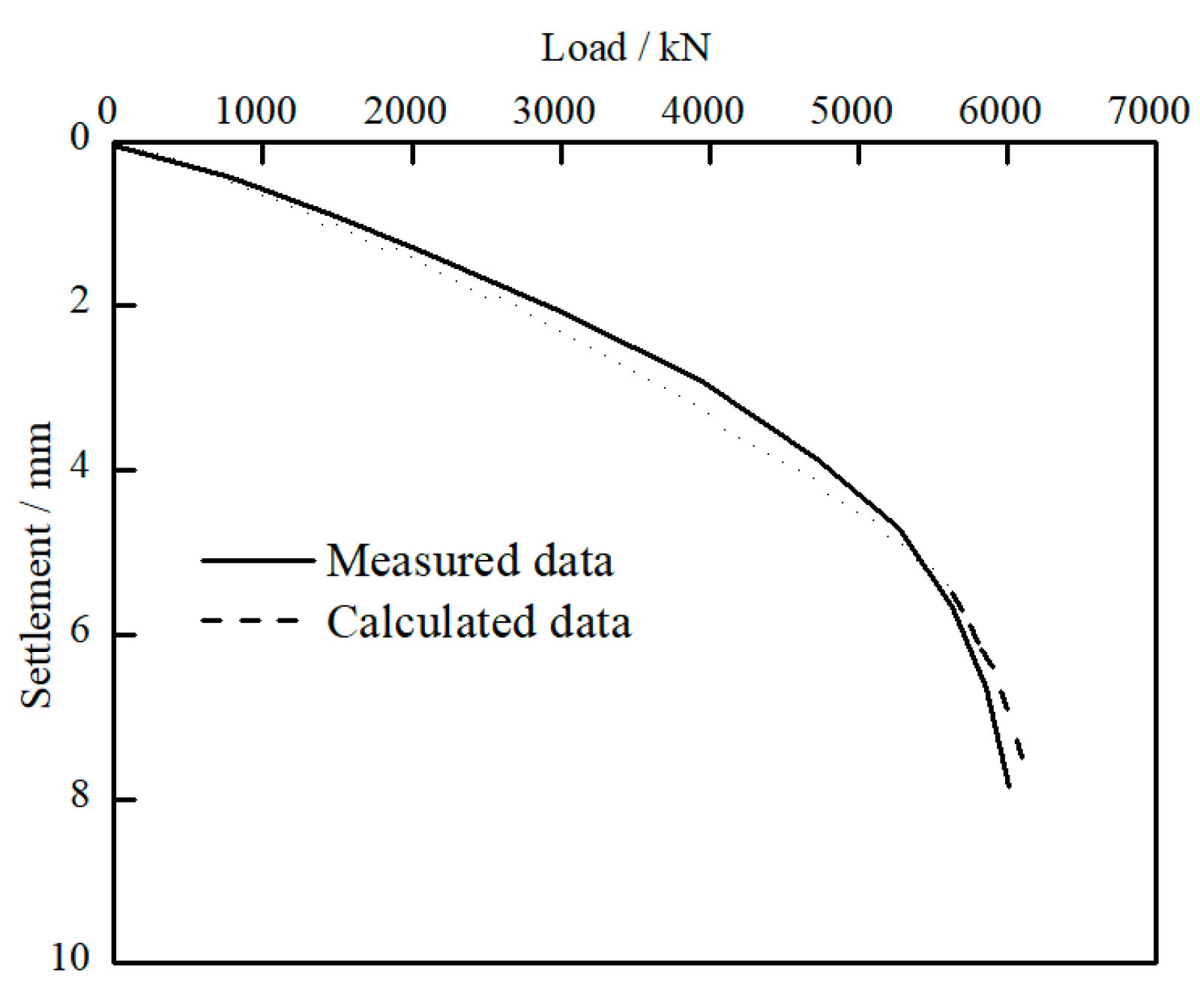
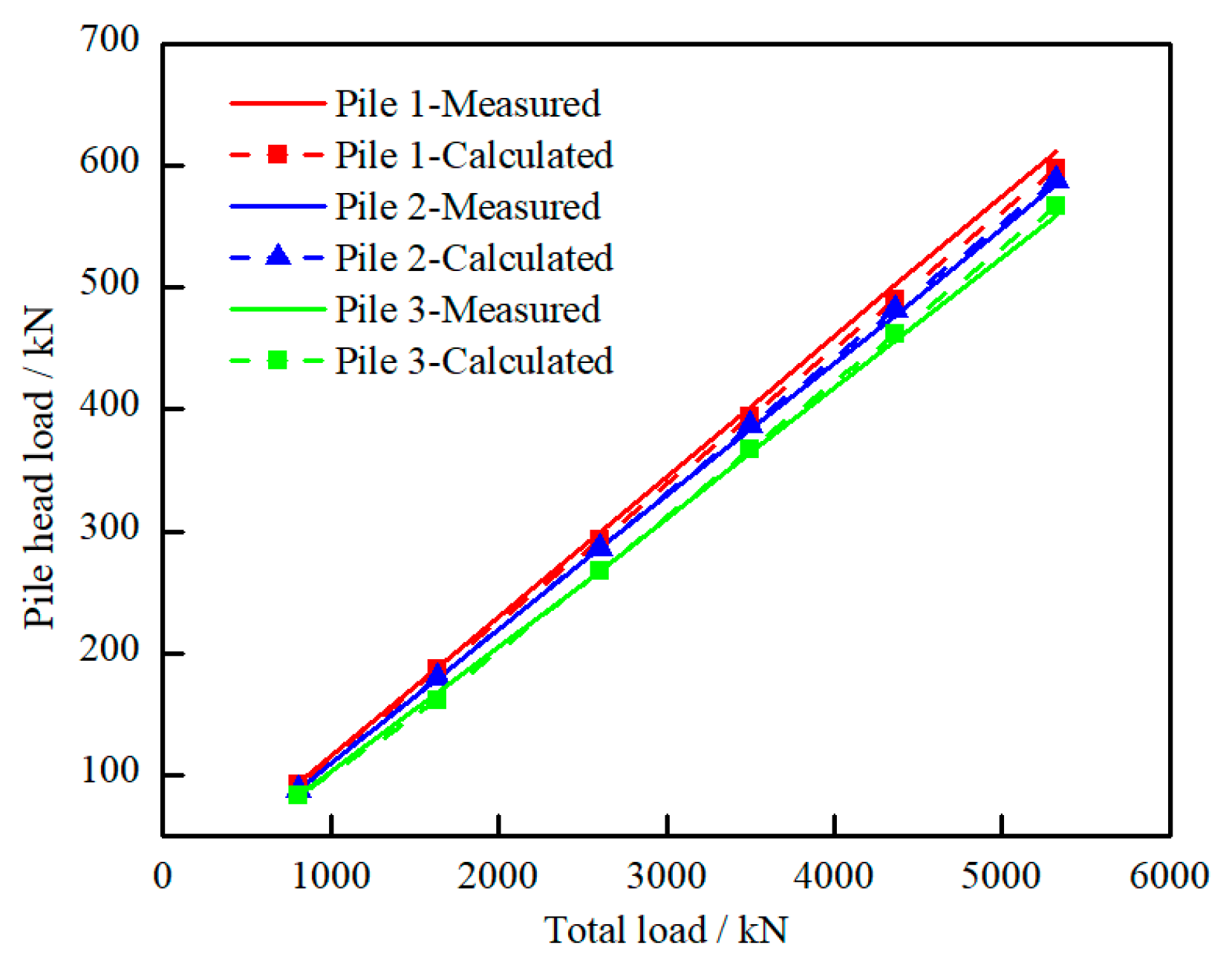

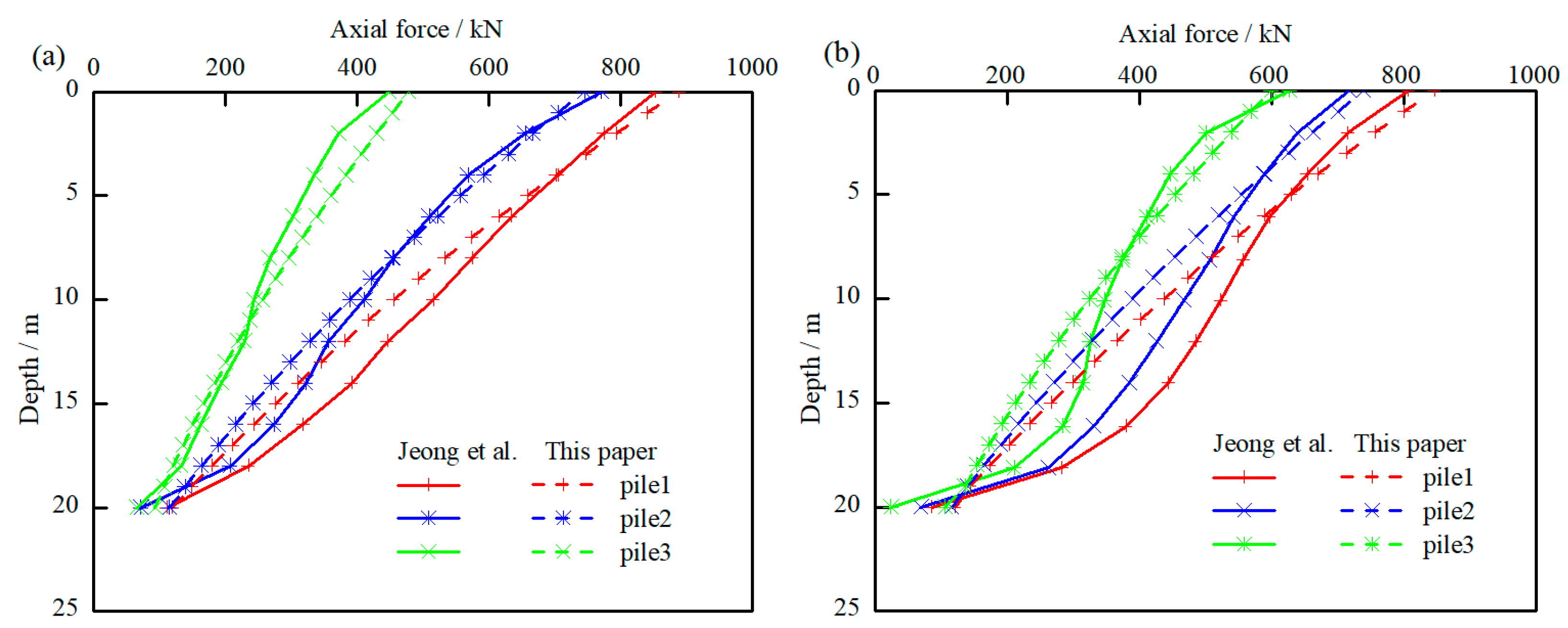
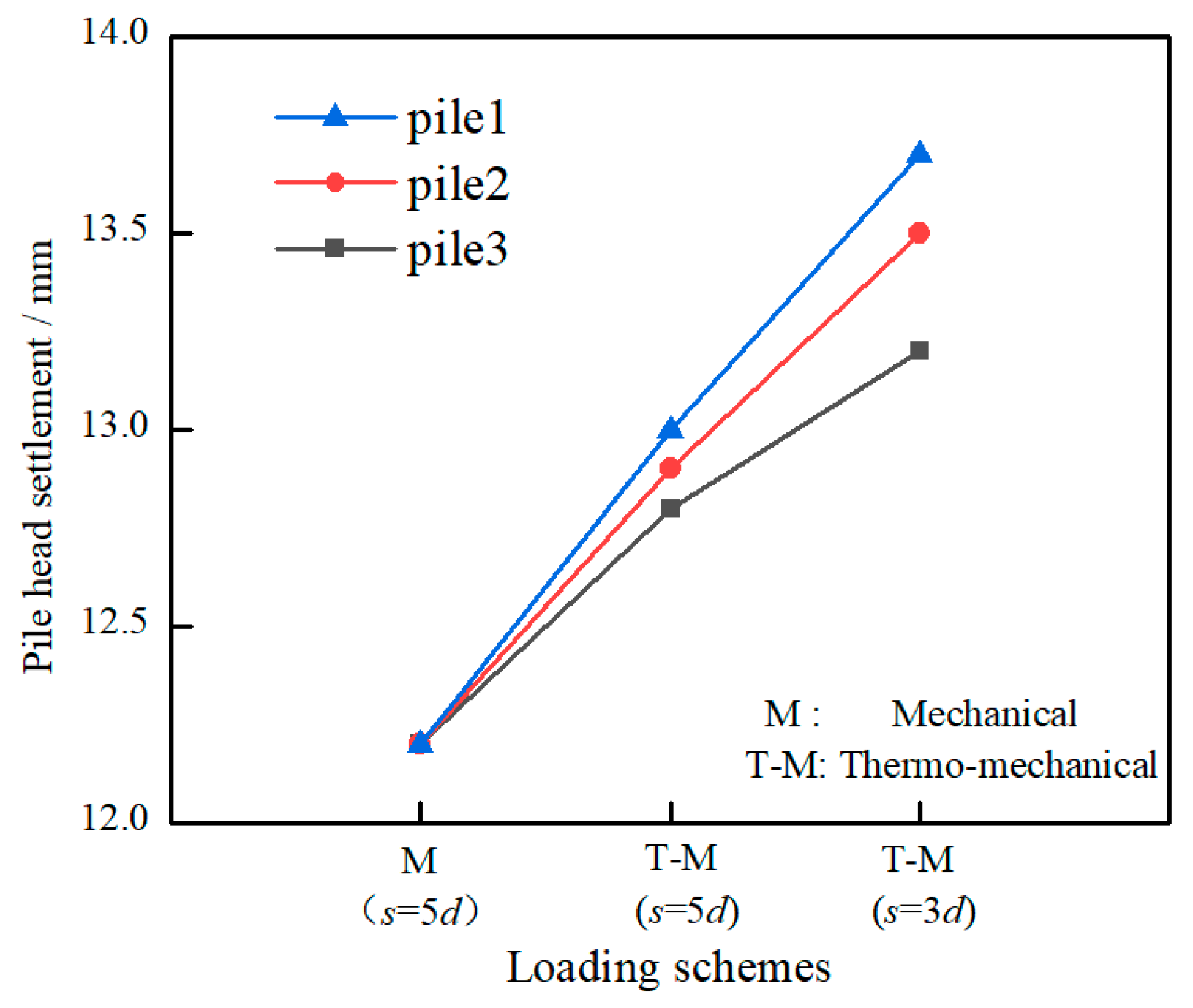
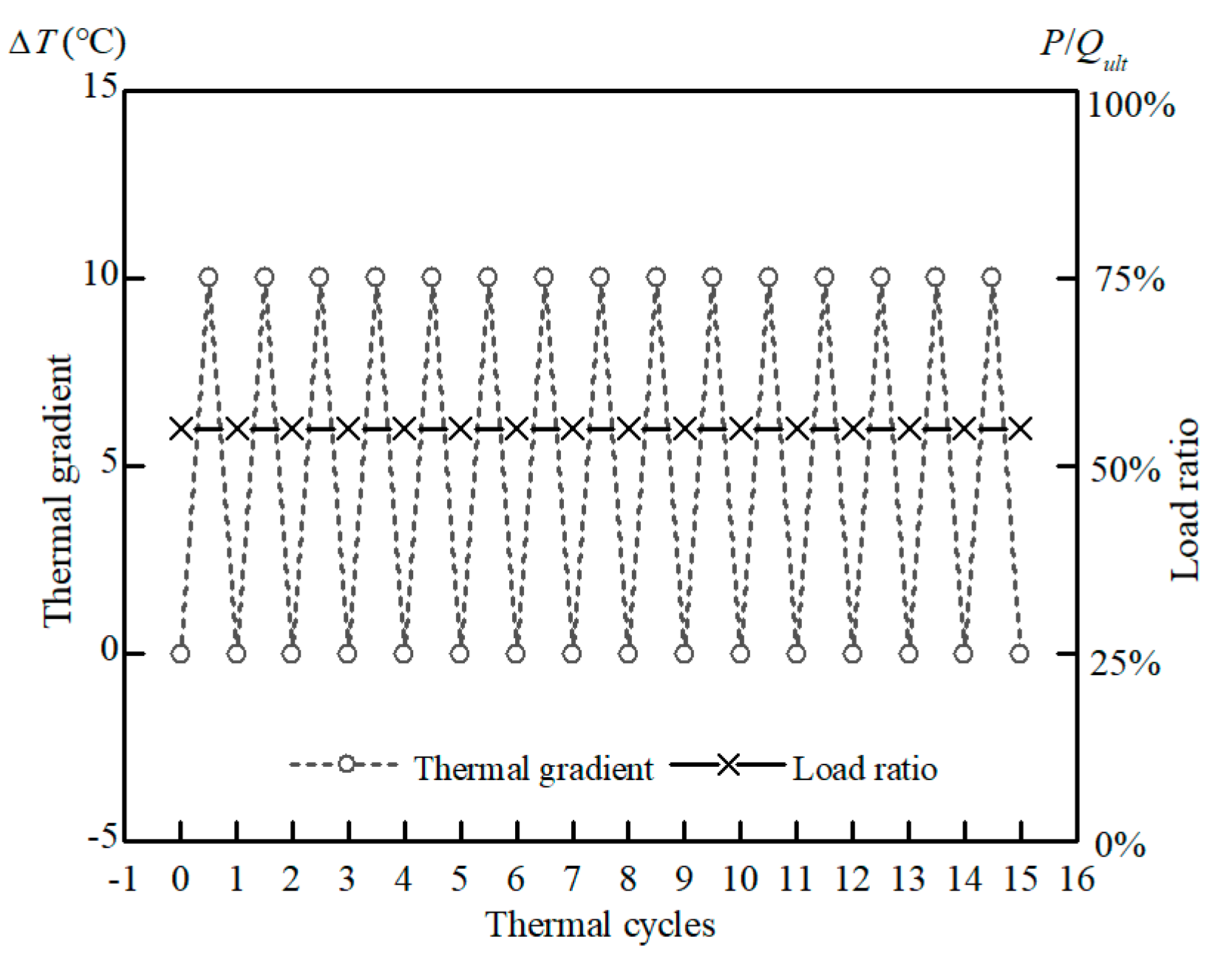
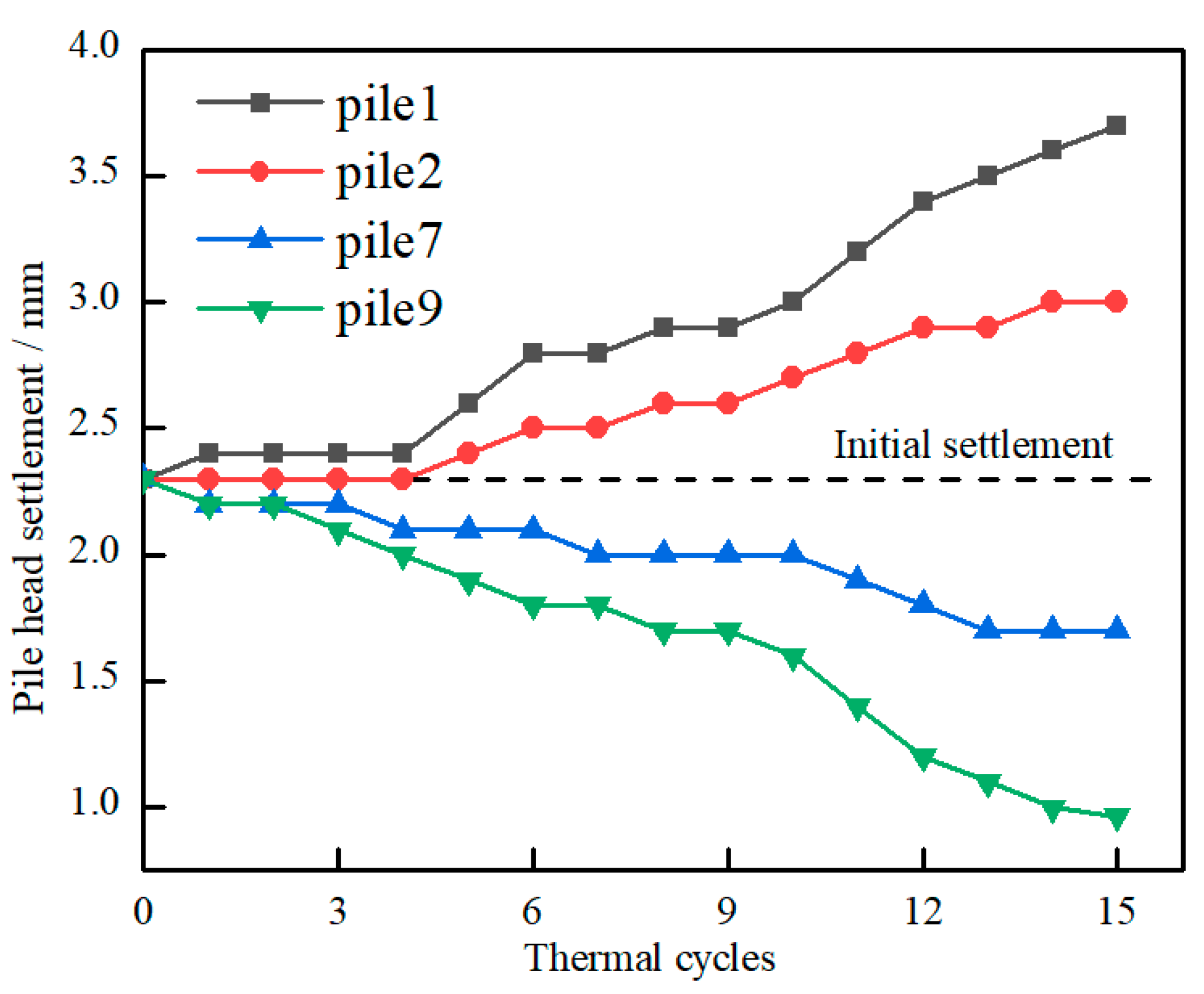
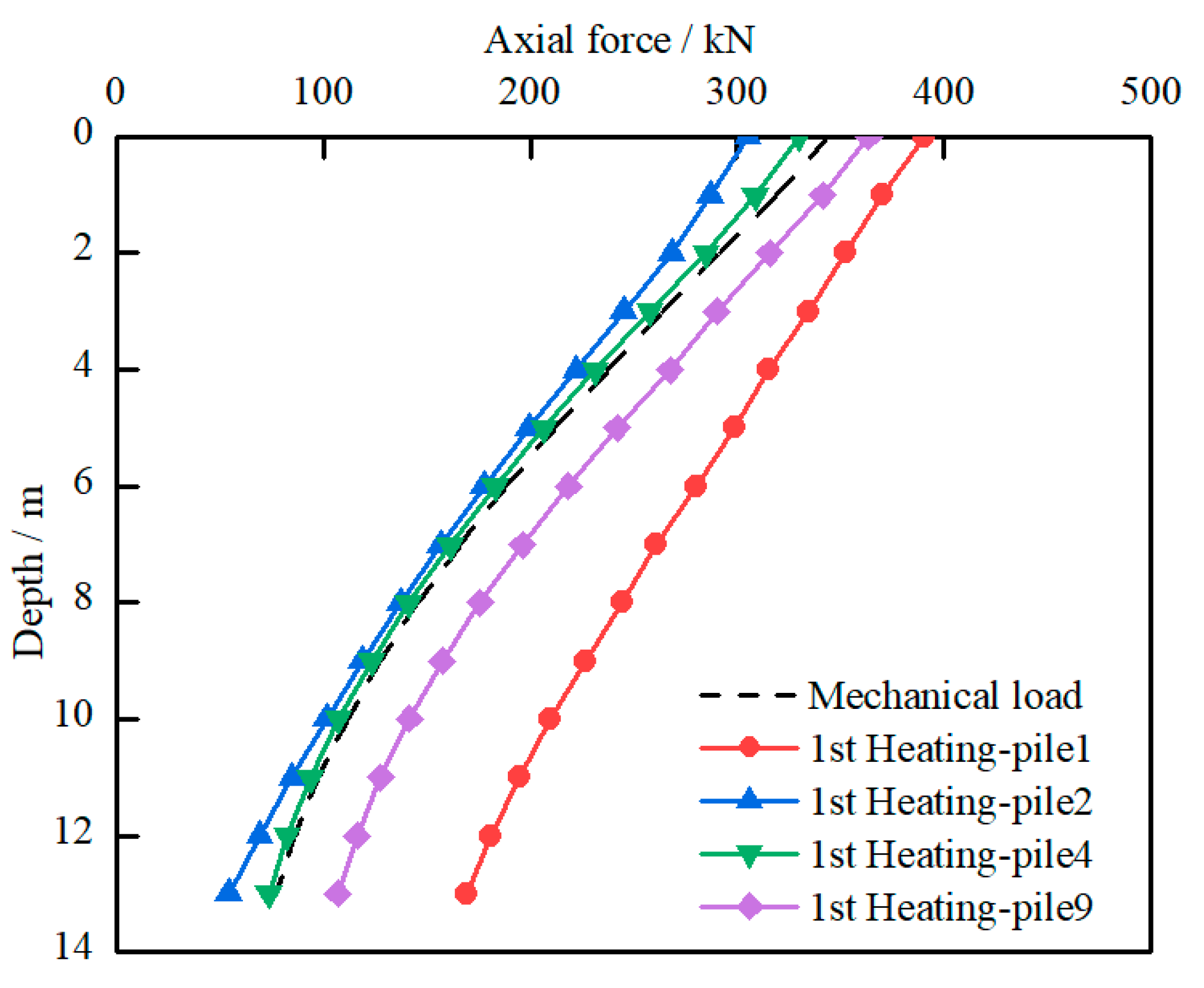
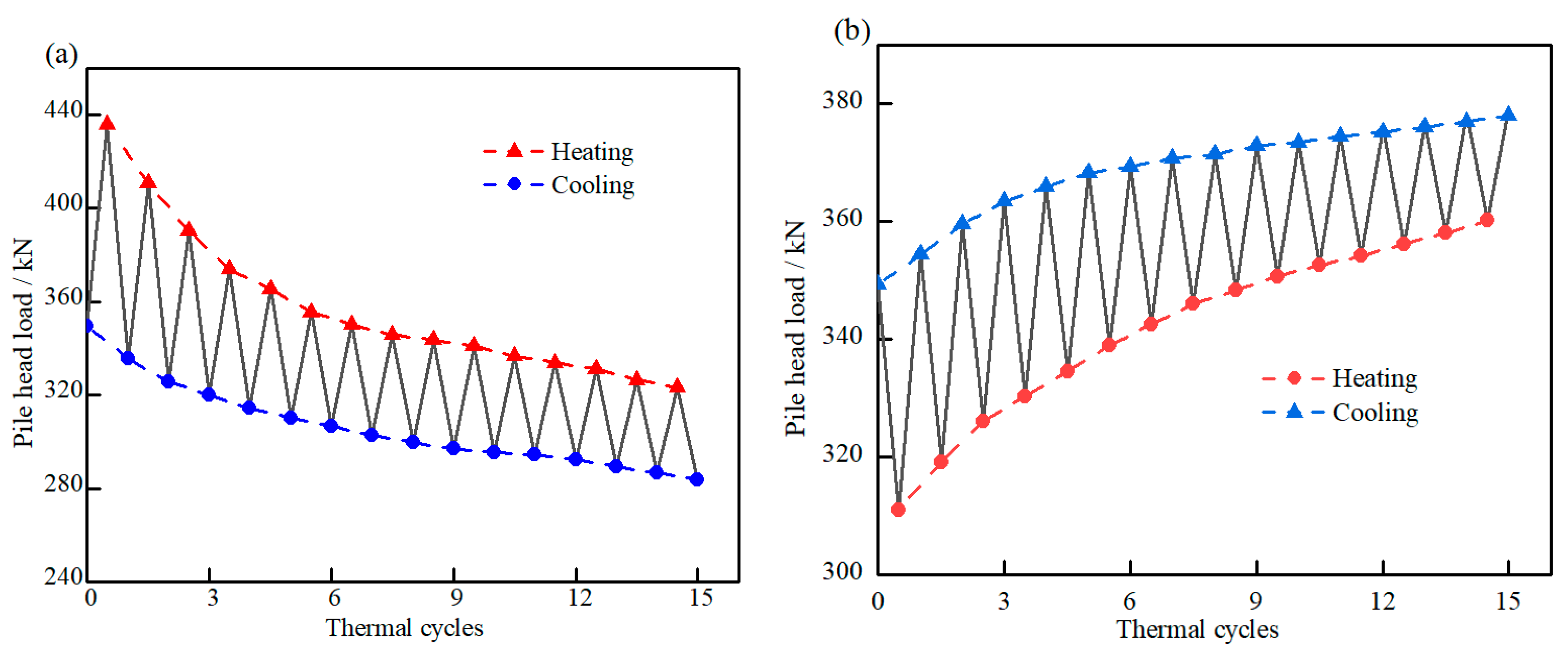
Publisher’s Note: MDPI stays neutral with regard to jurisdictional claims in published maps and institutional affiliations. |
© 2021 by the authors. Licensee MDPI, Basel, Switzerland. This article is an open access article distributed under the terms and conditions of the Creative Commons Attribution (CC BY) license (https://creativecommons.org/licenses/by/4.0/).
Share and Cite
Li, L.; Dong, L.; Lu, C.; Wu, W.; Wen, M.; Liang, R. Analysis of Bearing Characteristics of Energy Pile Group Based on Exponential Model. Energies 2021, 14, 6881. https://doi.org/10.3390/en14216881
Li L, Dong L, Lu C, Wu W, Wen M, Liang R. Analysis of Bearing Characteristics of Energy Pile Group Based on Exponential Model. Energies. 2021; 14(21):6881. https://doi.org/10.3390/en14216881
Chicago/Turabian StyleLi, Lichen, Longlong Dong, Chunhua Lu, Wenbing Wu, Minjie Wen, and Rongzhu Liang. 2021. "Analysis of Bearing Characteristics of Energy Pile Group Based on Exponential Model" Energies 14, no. 21: 6881. https://doi.org/10.3390/en14216881
APA StyleLi, L., Dong, L., Lu, C., Wu, W., Wen, M., & Liang, R. (2021). Analysis of Bearing Characteristics of Energy Pile Group Based on Exponential Model. Energies, 14(21), 6881. https://doi.org/10.3390/en14216881







